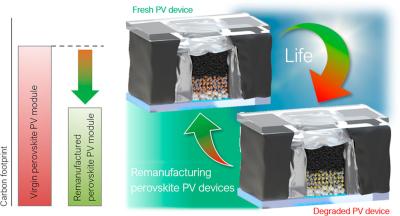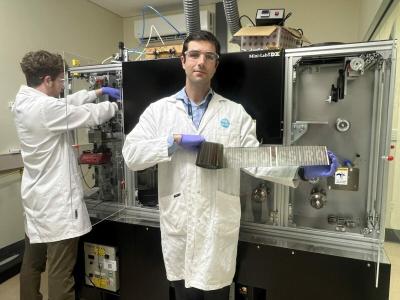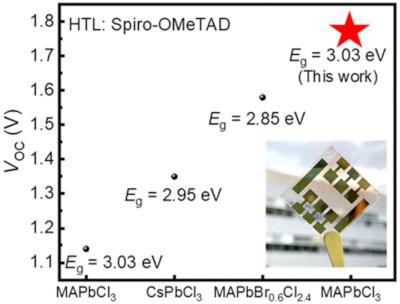What are perovskite?
Perovskites are a class of materials that share a similar structure, which display a myriad of exciting properties like superconductivity, magnetoresistance and more. These easily synthesized materials are considered the future of solar cells, as their distinctive structure makes them perfect for enabling low-cost, efficient photovoltaics. They are also predicted to play a role in next-gen electric vehicle batteries, sensors, lasers and much more.
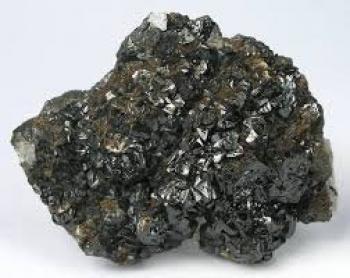
How does the PV market look today?
In general, Photovoltaic (PV) technologies can be viewed as divided into two main categories: wafer-based PV (also called 1st generation PVs) and thin-film cell PVs. Traditional crystalline silicon (c-Si) cells (both single crystalline silicon and multi-crystalline silicon) and gallium arsenide (GaAs) cells belong to the wafer-based PVs, with c-Si cells dominating the current PV market (about 90% market share) and GaAs exhibiting the highest efficiency.
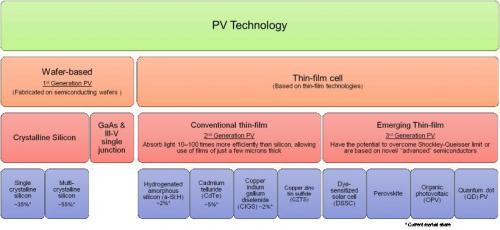
Thin-film cells normally absorb light more efficiently than silicon, allowing the use of extremely thin films. Cadmium telluride (CdTe) technology has been successfully commercialized, with more than 20% cell efficiency and 17.5% module efficiency record and such cells currently hold about 5% of the total market. Other commercial thin-film technologies include hydrogenated amorphous silicon (a-Si:H) and copper indium gallium (di)selenide (CIGS) cells, taking approximately 2% market share each today. Copper zinc tin sulphide technology has been under R&D for years and will probably require some time until actual commercialization.
What is a perovskite solar cell?
An emerging thin-film PV class is being formed, also called 3rd generation PVs, which refers to PVs using technologies that have the potential to overcome current efficiency and performance limits or are based on novel materials. This 3rd generation of PVs includes DSSC, organic photovoltaic (OPV), quantum dot (QD) PV and perovskite PV.
A perovskite solar cell is a type of solar cell which includes a perovskite structured compound, most commonly a hybrid organic-inorganic lead or tin halide-based material, as the light-harvesting active layer. Perovskite materials such as methylammonium lead halides are cheap to produce and relatively simple to manufacture. Perovskites possess intrinsic properties like broad absorption spectrum, fast charge separation, long transport distance of electrons and holes, long carrier separation lifetime, and more, that make them very promising materials for solid-state solar cells.
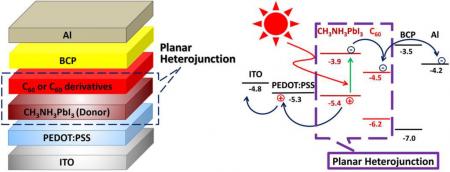
Perovskite solar cells are, without a doubt, the rising star in the field of photovoltaics. They are causing excitement within the solar power industry with their ability to absorb light across almost all visible wavelengths, exceptional power conversion efficiencies already exceeding 20% in the lab, and relative ease of fabrication. Perovskite solar cells still face several challenge, but much work is put into facing them and some companies, are already talking about commercializing them in the near future.
What are the advantages of Perovskite solar cells?
Put simply, perovskite solar cells aim to increase the efficiency and lower the cost of solar energy. Perovskite PVs indeed hold promise for high efficiencies, as well as low potential material & reduced processing costs. A big advantage perovskite PVs have over conventional solar technology is that they can react to various different wavelengths of light, which lets them convert more of the sunlight that reaches them into electricity.
Moreover, they offer flexibility, semi-transparency, tailored form factors, light-weight and more. Naturally, electronics designers and researchers are certain that such characteristics will open up many more applications for solar cells.
What is holding perovskite PVs back?
Despite its great potential, perovskite solar cell technology is still in the early stages of commercialization compared with other mature solar technologies as there are a number of concerns remaining.
One problem is their overall cost (for several reasons, mainly since currently the most common electrode material in perovskite solar cells is gold), and another is that cheaper perovskite solar cells have a short lifespan. Perovskite PVs also deteriorate rapidly in the presence of moisture and the decay products attack metal electrodes. Heavy encapsulation to protect perovskite can add to the cell cost and weight. Scaling up is another issue - reported high efficiency ratings have been achieved using small cells, which is great for lab testing, but too small to be used in an actual solar panel.
A major issue is toxicity - a substance called PbI is one of the breakdown products of perovskite. This is known to be toxic and there are concerns that it may be carcinogenic (although this is still an unproven point). Also, many perovskite cells use lead, a massive pollutant. Researchers are constantly seeking substitutions, and have already made working cells using tin instead. (with efficiency at only 6%, but improvements will surely follow).
What’s next?
While major challenges indeed exist, perovskite solar cells are still touted as the PV technology of the future, and much development work and research are put into making this a reality. Scientists and companies are working towards increasing efficiency and stability, prolonging lifetime and replacing toxic materials with safer ones. Researchers are also looking at the benefits of combining perovskites with other technologies, like silicon for example, to create what is referred to as “tandem cells”.
Commercial activity in the field of perovskite PV
In September 2015, Australia-based organic PV and perovskite solar cell (PSC) developer Dyesol declared a major breakthrough in perovskite stability for solar applications. Dyesol claims to have made a significant breakthrough on small perovskite solar cells, with “meaningful numbers” of 10% efficient strip cells exhibiting less than 10% relative degradation when exposed to continuous light soaking for over 1000 hours. Dyesol was also awarded a $0.5 million grant from the Australian Renewable Energy Agency (ARENA) to commercialize an innovative, very high efficiency perovskite solar cell.
Also in 2015, Saule Technologies signed an investment deal with Hideo Sawada, a Japanese investment company. Saule aims to combine perovskite solar cells with other currently available products, and this investment agreement came only a year after the company was launched.
In October 2020, Saule launched sunbreaker lamellas equipped with perovskite solar cells. The product is planned to soon be marketed across across Europe and potentially go global after that.
In August 2020, reports out of China suggested that a perovskite photovoltaic cell production line has gone into production in Quzhou, east China's Zhejiang Province. The 40-hectare factory was reportedly funded by Microquanta Semiconductor and expected to produce more than 200,000 square meters of photovoltaic glass before the end of 2020.
In September 2020, Oxford PV's Professor Henry Snaith stated that the Company's perovskite-based solar cells are scheduled to go on sale next year, probably by mid 2021. These will be perovskite solar cells integrated with standard silicon solar cells.
The latest perovskite solar news:
Macnica develops a new air quality sensor that uses perovskite solar cells and semi-solid batteries
Macnica, a Technology Solutions Partner that provides products, services, and solutions, has announced a new type of air quality sensor that uses perovskite solar cells and semi-solid batteries. The sensor uses perovskite solar cells from EneCoat Technologies, a startup from Kyoto University.
It was reported that for several years, an indoor perovskite solar cell effectiveness demonstration project has been taking place in the company's office in Tokyo. Through this demonstration project, it was reportedly demonstrated that the technology can become a sustainable energy source in the future, including use under low illumination, and data on various issues was gathered toward the practical application of perovskite solar cells.
Researchers report roll-to-roll production of efficient perovskite solar cells in ambient conditions
An international collaboration between scientists from CSIRO, University of Cambridge and others has resulted in a new efficiency record for fully roll-to-roll printed solar cells.
According to the team, the cells achieved “power conversion efficiencies of up to 15.5% for individual small-area cells and 11.0% for serially-interconnected cells”.
Researchers examine prospects of vapor-based deposition to short track perovskite PV's road to commercialization
A large international group of researchers worked together to form a balanced viewpoint on the prospects of vapor-based processing of perovskite PV on an industrial scale.
Their perspective highlights the conceptual advantages of vapor phase deposition, discusses the most crucial process parameters in a technology assessment, contains an overview about relevant global industry clusters, and provides an outlook on the commercialization perspectives of the perovskite technology in general.
Kunshan GCL Photoelectric Materials announces 19.04% efficiency on single-junction perovskite modules (1,000mmx2,000mm)
Reports suggest that China-based GCL (via its new subsidiary Kunshan GCL Photoelectric Materials) has achieved a photoelectric conversion efficiency of 19.04% on a 1,000mm x 2,000mm single-junction perovskite solar module. The result was reportedly officially tested by the China National Institute of Metrology to confirm the results.
The GCL Perovskite team stated it is "delighted to have achieved its goal of surpassing the expected conversion efficiency of 19% for standard-sized perovskite modules, having previously achieved 18.04% conversion efficiency for a single-junction perovskite solar module in November 2023". And the team is one step closer to its efficiency target of 26% for a 2m² (1,000mm × 2,000mm) single-junction perovskite solar module, while focusing on research and development for the next generation of tandem perovskite modules.
Japan to promote perovskite solar technology through feed-in tariffs
According to reports, Japan's government plans to advance perovskite flexible solar power panels through the country's feed-in tariff system, seeking to encourage investment in the technology. The Ministry of Economy, Trade and Industry plans to set the price of energy produced from perovskite cells at 10 yen (6 cents) per kilowatt-hour or more, higher than the current level for solar power, starting as early as fiscal 2025.
Light, flexible perovskite cells can generate electricity in places where traditional solar panel installation is not feasible, such as building walls and windows. The base technology is Japanese, and Japanese companies are involved in vigorous R&D with emphasis on quality and durability. At the same time, Chinese companies have begun mass production and are leading in commercialization.
Researchers develop method for re-manufacturing perovskite solar cells and modules
An international group o researchers, including ones from the Fraunhofer Institute for Solar Energy Systems ISE, Solaronix, University of Cambridge, École Polytechnique Fédérale de Lausanne (EPFL) and others, have developed a method to re-manufacture fully encapsulated perovskite solar cells after recycling. According to the researchers, the re-manufactured devices can achieve 88% of their original efficiency.
The novel method for re-manufacturing perovskite solar cells (PSCs) uses carbon-based electrodes (CPSMs). Re- manufacturing, as opposed to merely recycling, is described as the combination of re-used, recycled, repaired, or replaced parts to make a new product. “In this work, we demonstrate for the first time a re-manufacturing strategy for glass-glass encapsulated perovskite solar cells,” the scientists stated. “Our study presents a facile experimental method to remove the edge-sealant, encapsulant, back electrode, and degraded perovskite, allowing reuse of the device constituents.”
Printed flexible solar cells by CSIRO launched on Space Machine Company’s Optimus-1 satellite, as part of Space X’s Transporter-10 mission
Eight mini-modules of the Commonwealth Scientific and Industrial Research Organization's (CSIRO) printed flexible solar cells were attached to the surface of Australia-based space transportation provider Space Machine Company’s Optimus-1 satellite, that was sent into orbit from the United States as part of Elon Musk’s Space X’s Transporter-10 mission.
A statement from the national science agency following the launch from Vandenberg Space Force Base in California explained that it is exploring such solar cells as a reliable energy source for future missions. Eight mini-modules of the printed flexible solar cells were attached to the surface of Optimus-1.
Researchers develop record efficiency triple-junction solar cells using cyanate
Researchers at the National University of Singapore (NUS), Beijing University of Technology, Suzhou Maxwell Technologies and Technical University of Munich have developed a triple-junction perovskite/Si tandem solar cell that can reportedly achieve a certified world-record power conversion efficiency of 27.1% across a solar energy absorption area of 1 sq cm, representing the best-performing triple-junction perovskite/Si tandem solar cell thus far. To achieve this, the team engineered a new cyanate-integrated perovskite solar cell that is stable and energy efficient.
Current multi-junction solar cell technologies pose many issues, such as energy loss which leads to low voltage and instability of the device during operation. To overcome these challenges, Assistant Professor at NUS, Hou Yi, led a team of scientists to demonstrate, for the first time, the successful integration of cyanate into a perovskite solar cell to develop a novel triple-junction perovskite/Si tandem solar cell that surpasses the performance of other similar multi-junction solar cells.
Researchers use thin perovskite layers to improve stability and efficiency of perovskite solar cells
King Abdullah University of Science and Technology (KAUST) scientists, along with collaborators from Ulsan National Institute of Science and Technology (UNIST) and Chinese Academy of Sciences (CAS), have reported a new strategy to design perovskite solar cells (PSCs) that improves their stability and raises their efficiency.
Image credit: KAUST
Defects at the top and bottom interfaces of three-dimensional (3D) perovskite photo-absorbers diminish the performance and operational stability of PSCs due to charge recombination, ion migration, and electric-field inhomogeneities. In this recent work, the team demonstrated that long alkyl-amine ligands can generate near-phase pure two-dimensional (2D) perovskites at the top and bottom 3D perovskite interfaces and effectively resolves these issues.
Researchers report single-junction transparent perovskite solar cell with record voltage of 1.78 V
Researchers from the University of Stuttgart, Forschungszentrum Jülich, Brandenburg University of Technology Cottbus-Senftenberg and University of Victoria have reported 'the highest open-circuit voltage recorded to date' for a single-junction perovskite solar cell based on hybrid methylamine lead chloride (MAPbCl3). The novel perovskite absorber was fabricated with a two-step deposition method and annealing under molecular nitrogen (N2) gas inside a glovebox.
Image from: ACS Publications
The team fabricated a single-junction transparent perovskite solar cell based on hybrid methylamine lead chloride (MAPbCl3), a perovskite material with one of the highest energy bandgaps among all perovskites. The team stated that this new cell could open the door for wide bandgap perovskites solar cells, which will be important not just for applications like Internet-of-Things (IoT) or solar windows, but also multijunction solar cells. The new work is especially noteworthy as single junction perovskites with wide bandgaps have not yet reached high voltages before.
Pagination
- Previous page
- Page 4
- Next page
